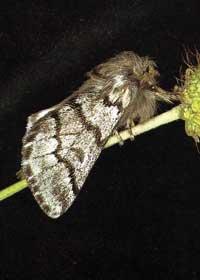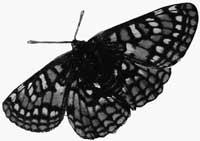Cacyreus marshalli: butterfly that has eaten your geranium
1998/02/01 Pagola Carte, Santiago Iturria: Elhuyar aldizkaria
What is Marshall's Cacyreus?
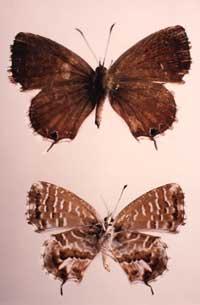
Cacyreus marshalli
The butterfly is small and generally brown, and most of the time it can be considered pretty pretty (see photo 1). His fast and nervous flight is often difficult to see. In the genus Cacyreus there are nine species, all but one, they are African. This genus is found within the family Lycaenidae, which is the most species in our territory, specifically forty-five, among the butterflies of the day. Although Lizénido's name, so said, will not give much information to many, it is a well-known group. Anyone who approaches the mountain has often seen small blue or blue butterflies, which are sometimes placed on the ground and sometimes fly as fast and high as to be able to follow in sight.
If we have so many licenids in Euskal Herria and that Cacyreus is African, why do we talk about this? It is very easy to understand, this butterfly that the Europeans invited to our house a few years ago and, what is more serious, also their fears (how not! ), indicating: “Come, come, here’s the food you like most without going far from our balconies.” What is happening on our balconies and on the rest of the peninsula? Well, we're running out of geranium. As we all know, it is often difficult to throw home guests...
Iberian Peninsula: chronicle of the epidemic announced
In November 1989 the German entomologist Stamer captured on the island of Mallorca 5 males and 8 females of this species. The following year the Germans published the large population of the island of Paguera. Knowing that the caterpillars of this butterfly feed on plants such as Geranium and Pelargonium in the South African Republic (home of origin), these researchers proposed: The appearance of Cacyreus marshalli in Mallorca is not due to a migration, but to its integration with the geraniums Pelargonium, food plant. To rule out the hypothesis of migration there were two reasons: on the one hand, not knowing in advance this type of trends in the species and, on the other, not having left a mark on the long road that goes from its usual residence to it; elsewhere, the absence of references to the butterfly.
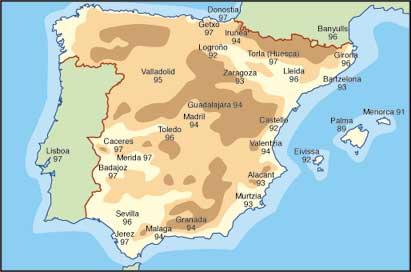
From here we can distinguish two periods of invasion. In the first it settled in the Balearic Islands, including also the lycéd in the islands Menorca and Ibivissa (it seems that in Formentera has not yet seen anyone); in the second, in addition to reaching the continent, it extends through the Iberian Peninsula. This colonization of Menorca and Ibiza took place in 1991-92 and soon after the citations began to be known throughout the Peninsula. The leap to the continent of this species of butterfly, however, did not occur in 1993, but a little earlier, according to data collected at different points of the Peninsula. As an example, on map 1 it can be observed that, on the margin of the Balearic Islands, although in most cities or towns specimens have been captured since 1993, in two cities (Logroño and Castellón) this species was observed for the year 1992.
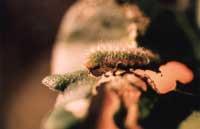
Today Sarto i Monteys may be the one who knows the most about this invasion. According to this entomologist, the point of invasion of the Peninsula has been unique and it seems that the Cacyreus marshall (the daratulo of the geraniums, translated directly from Spanish and Catalan) has reached a great success on this European end. It is known that the Mediterranean climate of the peninsular east is beneficial and can suffer winters on the plateau; we have to add something else: He also likes the oceanic climate of the Cantabrian, which this year has come to spend his holidays in Donostia and Getxo. And entomologist José Luis Yela announced in 1995 that he can act as a homodynamic species on the coast, that is, as other species that can produce generations continuously throughout the year. With this type of visitors, tourism is also insured in winter!
This scientist proposed two years ago an interesting hypothesis on the expansion of the butterfly: After “jumping” from the Balearic Islands to Alicante, opt for two expansion routes through the Peninsula, one to the south, which colonized the eastern Andalusia and another to the north, divided into two branches: Ramal to Catalonia that ascends along the river Ebro to La Rioja (see map 2). Well, at the end of 1997 it seems that we will have to take this hypothesis for good and, as we can see on map 3, all the mentions collected appear well enough through this scheme of branches.
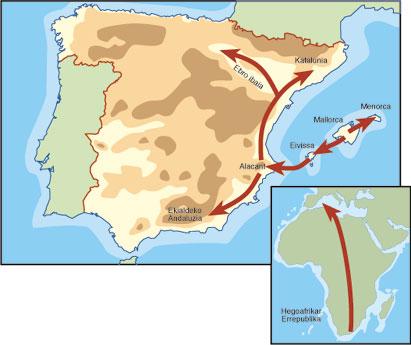
On the other hand, and seeing the speed and strength of expansion, we can raise a new hypothesis of the future: The zones that appear on map 3 without a butterfly will be covered shortly, but from now on the invasion can occur in all directions. It is possible that they enter with force in other European countries; it has been published the mention of a copy captured in August 1991 in Catalonia and Brussels by the butterflies that exceeded the Pyrenees last year.
Butterfly cycle = plant disaster
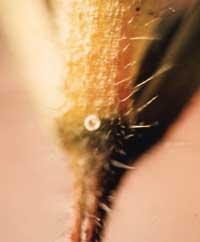
Like any lepidopter (butterfly or sits), the geranium drill develops through a complete life cycle. That is to say, it is a holometbolo insect and, therefore, it has the following phases: the egg, the larva that comes out of it, known as the trembling and that crosses different stages, the phase of immovable chrysalis, that is formed from the last stage of the caterpillar and, finally, the adult, male or female, that leaves the alide and whose main objective is the reproduction. Let's now see how all this remains in our Cacyreus marshalli or drill geraniums.
The female lays her eggs in the geranium's floral cocoons. These are white and relatively small (less than half a millimeter) and are found in the sepalos of the floral cocoons, but are also found in the pedicels, pedicels and bracts (see photo 2). It only takes ten days to take the caterpillar out of the egg, to pierce the cocoon that was under the egg (if it has not blossomed anymore) and to start eating the internal gineceo (the female organs of the flower). If that cocoon has already created a flower, it seems that caterpillars have no problems finding another green cocoon and therefore start feeding.
Caterpillars, as mentioned above, pass through several stadiums (see photo 3). In this species there are four stages, each of which represents a basic moment of skin variation and growth. The caterpillars of the first and second stages prefer flowers, but those of the final stages choose leaves and stems to the detriment of geraniums (as shown in photo 4). The body is generally green, but along these stages develops three longitudinal pink lines.
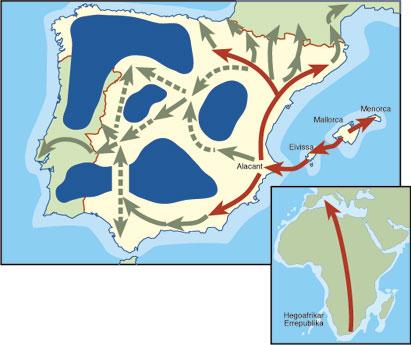
This herbaceous phase, which does not exceed two centimeters, will generate the phase of the following cycle: chrysalis (see photo 5), of similar dimensions and with a green color at the beginning. Like caterpillars, it is quite hairy, a very visible feature. In this motionless phase, which will last 12 days maximum and after that little time and after turning the outer color of the chrysalis into brown, comes a young butterfly dressed in all its beauty (as we can see in photo 6) Witness of the past in the plant, only the skin of the chrysalis will remain.
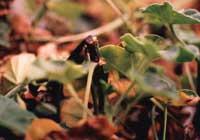
At the end of this cycle, which can be extended from one month to two months, we will see an adult flying over our geraniums, often standing in the sun, showing the white back of their wings; any of us can catch a female at the time of laying the eggs. From there the motto will begin again...
Clarifying the relationships between geraniaceae and butterflies
Although geranium daratulo is fed exclusively by geraniums, the caterpillars of other butterflies are more customary when it comes to bringing something to the mouth. It is very common, for example, that some species in the family of nocturnal butterflies Noctuidae also visit our geraniums and see their green and dense herbs, which are generally denounced for deyections abandoned in their camouflaged leaves. In all these cases, caterpillars do not specifically attack geraniums, that is, they have as food many other plant species. Therefore, they are called polyphonic species. In addition, they feed on the cocoons of geraniums and especially the leaves, not from the inside of the stems, so they do not cause the death of the plant.
Cacyreus marshalliren
the case is very different. Among the geraniaceae, in the genus Pelargonium we only have ornamental plants in the Basque Country, being P. zonale (mular geranium) and P. peltatum (climbing geranium) the most common. On the other hand, some savages also inhabit our mountains and pastures: Of genus Erodium and of genus Geranium as G. rotundifulium and G. robertianum. Well, the herbaceous phase of Cacyreus marshalli only eats the genus Pelargonium and, to choose, prefers the P. peltatum climbers. Here is the problem that the ornamental plants of our balconies have or will have.
Geranium anti-trailer measures
Ecological texts tell us about the processes of species dispersion. Krebs, for example, distinguishes in his classic book three important forms: diffusion or diffusion, the dispersion of leaps and long-term migration. The first and third cases indicate the processes that are carried out gradually: in the first case the movements of the population are seen after several generations and in the third it is necessary evolutionary times for the consequences to be noticed.
In the case of the dispersion of leaps, however, although the displacement or displacement can be very important, only one specimen (if extreme) can cause the fixation of the new population. The typical characteristic of these jumps is to cross inadequate territories. The colonizations of the newly formed islands and the cases of animals and plants introduced by man in new territories follow this scheme. This is also the case of the drill of geraniums, because after all, those who have introduced this species together with the plant of our balconies in Europe are human beings.
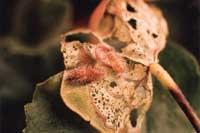
On the other hand, we have the concept of pest. Species that impede human activity can be considered as pests. This is the case of Cacyreus marshalli. However, plagues can be controlled by man, meaning that man can reduce the number of specimens of this pest population or stay in a harmless balance.
There are several ways to control the geranium drill. On the one hand there are insecticides; contact insecticides, which remain outside the plant, do not serve by the eating habits of the caterpillar, while systemic insecticides that enter the inside are more toxic... In addition, semi-wild geraniums can always be left, that is, untreated plants that help the butterfly to complete its life cycle and that are willing to recontaminate.
In the face of all this, we find another way that we can consider as the cleanest and most effective control: biological control. According to this, we choose among the species present in nature that can somehow control the plague and introduce it in this territory. In most cases, however, it is usually not so easy and, after seeing its advantages and drawbacks and thinking a lot, often go wrong. We would need a lot of time to delve into this topic and analyze the cases that are known, but we can advance something: as with many species that enter (or introduce) into a new territory, this nest has not been found any local parasite or predator, that is, the role played by some hymenoptera (wasps) or diptera (flies) in South Africa is empty and therefore control insects.
What measures have been taken so far? As it is a very new problem in Euskal Herria, it has not been taken into account. But in Catalonia and the Balearic Islands, information campaigns and tests on insecticides have already begun. The information seems to have great importance in the dispersion of the species. Let's set a perfect example to better explain what was said. The arrival of Cacyreus marshalli at high altitudes in the Pyrenees is attributed directly to the man, who acquired some geraniums in the town of La Seu d’Urgell (Lleida) and from there went up to the refuge Prat d’Aguiló, located in the Natural Park of Cadí-Moizeró (2.037 m). As the geranium was afraid, then the butterflies came out... and so the butterfly has found it very easy to colonize the pyrenean area. Will you be able to adapt to your conditions? With little geranium, you know if you will like a wild local...
Future, money and research
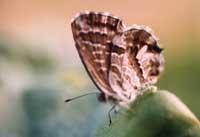
Pamplona fired for the first time the butterfly in 1994 and the plague that San Sebastián has known this summer are only the ends of a powerful process. It is possible that from now on we talk much more about this animal and that, of course, would not be very good for the beloved plants of our vases. Yes, it is possible that before this small butterfly the geraniums of the peninsula and perhaps of all Europe.
If we attend to José Luis Yela, there are many reasons to investigate the dispersion of the South African lycéd, precisely because of the plague of the geraniums from an applied point of view. Let's remember how many people live around this plant: In Spain, for example, the 10 million rafts sold represent 3 billion pesetas per year.
On the other hand, from a purely scientific point of view, research is very attractive, since as a foreign element human beings have been extended to new territories that could not be accessed through their capacity for dispersion. How does it expand? What conditions are you looking for? How does it affect the rest of life? The search for answers to all these questions, in addition to knowing more about these lepidoptera, will probably also allow you to know more about the functioning of ecosystems. Next to this Geranium/Daratulua binomial, there is another particularity before us: both the insect and the plant have been transported by humans from one continent to another. Both, in their original territory, kept the balance, but here the plants could not see the butterfly... The same species and the situation so different! Who has broken the balance? Or in other words, who has failed to bring the balance of South Africa to Europe?

Gai honi buruzko eduki gehiago
Elhuyarrek garatutako teknologia




